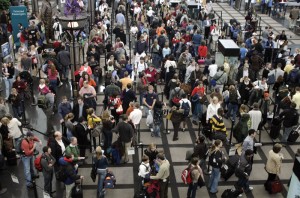The Transportation Safety Administration (TSA) is currently in full meltdown. Several airports have actually replaced TSA screeners with private companies. Public figures from all political persuasions have entered the debate, several suggesting outright privatization of the TSA. Kelly Hoggan, who had served as TSA assistant administrator for security operations, has been fired, following wait periods approaching three hours at Los Angeles, La Guardia, O’Hare, Miami, and JFK, to name just a few.
Four times in the wake of 9/11 I have examined the state of airport security and our ability to set up highly effective airport and airline security screening. We could have implemented this program within three months of 9/11 – three years and six months ago. We could implement it three months from now. (See “Airline Safety: Simple Steps for Better Security,” DefenseWatch, Nov. 14, 2001, “Security, Common Sense and Gen. Joe Foss,” DefenseWatch, Feb, 20, 2002, “Another Enemy Within – Agency Turf Fights,” DefenseWatch, June 26, 2002, “Airport Security – An Update,” DefenseWatch, Nov. 20, 2002). Over the years, I have republished the essence of this article, just to remind people of what we could have accomplished, while looking as the actuality of what we did accomplish – if you can call it that.
Back in 2001 I wrote that from the get-go, the problem we faced was fundamentally, profoundly simple. Strip away all the rhetoric and all the fuss, and the problem became: Prevent any bad guys or bad stuff from getting on any aircraft.
It really is that simple.
Here is the seven-point program I suggested that would have accomplished everything necessary in about three months. The plan included:
First, assign security responsibility to airports, not the airlines or feds. The simple reason is that each airport manager knows better than anyone else where and how to install and effectively implement security in the various airport buildings and terminals under his control. Give the airport managers the ball and let them run with it.
Second, the feds should pay the initial costs for manufacturing the necessary equipment – no matter how many tens or hundreds of millions of dollars this would have taken, and pay for the initial airport security installations. This needed to be done immediately, on a crash priority basis, like the bomber production during the initial stages of World War II. Then let passengers pay the final costs with a $25 per ticket surcharge, eventually reimbursing the federal government for all costs, and carrying the financial load going forward.
Third, there should be immediate inspection of all baggage, including hold baggage, using initial computerized screening to speed up the process, augmented by hand inspections of items rejected by the initial screening. Software is either available now to accomplish this, or can be generated in days to weeks, if sufficient cash is thrown at the problem. With the crash production of the various state-of-the-art machines that can carry out these inspections with increasing automation, the long lines would soon give way to efficient passenger processing.
Fourth, security should screen all passengers against databases of known suspects, applying the latest computer technology. Where possible, this screening can take place in advance of travel, by comparing ticketed passengers against various databases. At the time of check-in and boarding, face recognition technology and other state-of-the-art methods can be used to ensure that every passenger is positively identified. Bottom line is: If we don’t know who you are, you don’t get on that plane!
Fifth, match hold baggage to passengers using transmitting chips on baggage and boarding passes. This will insure that every piece of hold baggage belongs to someone actually aboard the aircraft. A twist on this is to attach a wrist band to each passenger upon boarding (like a hospital ID band), that registers on a panel available to crew members. The panel displays simultaneously the passenger’s assigned seat, the hold luggage, and the passenger’s actual location on the plane at any moment. An additional refinement would attach another band to each carry-on item, so that its location can be continuously monitored as well. This is mature technology, needing only to be adapted to this specific purpose.
Sixth, arm aircrew members with non-lethal weapons, or with weapons that will not threaten the integrity of the aircraft, and train them to use these weapons effectively. Which crew members and what weapons can be worked out during the initial implementation stages.
Seventh, require all personnel associated with airport and airline operations to take random, unannounced flights. Each person associated with any aspect of flight operations where safety could be an issue will make periodic flights with no advance notice. This process will ensure that no affected employee will perform haphazardly, since the result of such poor performance could materially affect that person’s own safety. This follows the theory that if I am required to jump the parachute I personally packed, I will ensure absolutely that it is packed flawlessly.
Had Congress passed legislation implementing this program immediately following 9/11, within three months at most every major airport and most smaller ones would have been equipped with one or more of the machines necessary to implement my suggestions. The software would have been created and debugged, and the necessary building modifications would have been accomplished. By month six, the entire program down to the smallest facility would have been on line.
Sure it would have cost a bundle, but probably not so much as the actual 14-month delay cost. Sure it would have affected the federal budget initially, but since the entire cost would eventually have been repaid by flying passengers, cost to the government becomes a non-issue.
The following short account from 2005 will make perfectly clear a significant part of the problem we face today. My wife and I arranged to ship our fourteen-year-old twin boys from Lewiston, Idaho, to Denver, Colorado, to spend the Spring Break with their biological father. Although the boys had traveled by themselves before, this was to be the first time they would need to change planes by themselves in a strange airport without adult supervision. They were both excited and a bit apprehensive.
We stood with them in the relatively short and fast Lewiston Regional Airport security line. The first twin moved through security without a hitch – they had been well briefed by their mother. The second twin, the more reserved of the pair, seemed to be having a smooth passage when a red light flashed, and a TSA agent moved quickly to intercept the lad. “You,” he said with a grin, “have been randomly selected for a full examination.” The boy looked at his mother and then at me. We could see the fear rising in him. He was required to wait in a chair by himself while the TSA crew worked through the long line, until they had time for his detailed inspection.
The TSA agent snapped on his latex gloves. The boy’s eyes widened. Then he was ordered to move to an isolated area of the inspection station. I could tell that he was frightened, but trying hard to control himself. The TSA agent patted him down and did everything but strip-search him. They finally let him join his brother, and the boys went on to board the plane.
Our son was obviously part of a family, obviously flying alone with his brother, obviously young and inexperienced, obviously anything but a terrorist. I understand the concept of a random search, but TSA agents need the discretion to make a judgment-call regarding a 14-year-old boy, an 80-year-old grandmother, or an infant in a diaper. This situation clearly demonstrates what the federal TSA system has become – another federal boondoggle, run and manned by idiots, although I’ll give a pass to the on-line agents who are not allowed to exercise any kind of judgment at all.
This is what we have instead of what we could have had.
So…where are we today with airport security? It is a week before Memorial day, and the lines are longer than ever. Travelers are actually missing flights because of these delays. Weapons run through security check-points to test the system get through undetected 90% of the time. Not one single potential terrorist has been identified and stopped by any TSA agent anywhere in the country. We taxpayers are paying hundreds of millions of dollars, while receiving absolutely nothing in return.
I would fire the whole lot and implement my suggestions as listed above as quickly and completely as time would allow.






Sorry, comments are closed for this post.